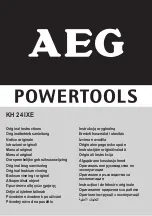
3. FUNCTION OF ROTARY PNEUMATIC HAMMER
4. OPERATING INSTRUCTION
6
EN
FUNCTION OF ROTARY PNEUMATIC HAMMER
OPERATING INSTRUCTIONS
The impact needed for hammer drilling in stone is created by a pneumatic hammer
striking mechanism. Similar to hitting a common chisel with a hammer, a plunger
hits the axially moving chisel. The electric motor moves the plunger back and forth
crank drive->piston->freely moving piston. There is a pneumatic cushion between
piston and freely moving piston(pneumatic hammer mechanism).
This results in a highly effective hammering action.
1.
Mains connection.
Connect only to a single-phase AC current supply and only
to the mains voltage specified on the rating plate. The machine accords
with IEC 60745, and it can be connected to sockets without earth protection
because of double insulation. Radio suppression complies with the international
standard CISPR 14.
2.
Switch on and off .
Switching on: press trigger switch (Fig.A Pos.5).
Switching off: release trigger switch.
3. Speed change dial.
Your tool equipped with a speed change dial (Fig.A Pos.6)
with 6 positions. The 1 position indicates the lowest speed, the 6 position
indicates the highest speed.
4
.
Inserting hammer drill bit or chisel (See Fig.B).
Always disconnect the plug
from the socket before carrying out any work on the machine.
The following tools can be inserted in the drill-hammer chuck using
the SDS-max shank: hammer-drill, pointed chisel, flat chisel, hollow chisel.
Only use accessories with SDS-max shank!
• Clean and grease the shank of the bit
• Push the drill chuck (2) back, insert the SDS drill or chisel into the machine
until you feel it lock into place.
• Check that the bit is properly locked into place. It must be possible to move
it back and forth.
4.
Tool removal (See Fig.B).
Pull back the drill chuck (2) in direction of arrow
and remove bit.
5.
Positioning the auxiliary handle.
Loosen the auxiliary handle (Fig.A Pos.7)
by turning it counter-clockwise. Then turn the auxiliary handle to the position
which is best for you. Turn the auxiliary handle clockwise until the auxiliary
handle sits tightly and can no longer be moved.
Setting the depth gauge.
For drilling to specific depth, insert the depth gauge
6.
(Fig.A Pos.2) into the provided boring in the handle and fasten it at the required
drilling depth.
7
EN
7.
Switching between hammer drilling and chiseling.
Depending on the inserted tool the machine can be operated with
additional rotation (SDS-max-drills) or without additional rotation
(SDS-max-chisels).
Operation mode - hammer drilling.
Set the selection lever (Fig.A Pos.4) on the hammer drilling position
to allow the inserted tool to rotate on the longitudinal axle.
Operation mode - chiseling
Set the selection lever (4) on the chiseling position to work on concrete,
stone, or brick.
In "free turning position" the chisel can be turned by hand to the required
angle. Afterwards lock the spindle with the selector lever while turning the
chisel slightly.
During no-load operation the pneumatic hammer mechanism is not yet
activated even if the hammer mechanism is switched on.
To activate the pneumatic hammer mechanism all you have to do is to firmly
push the running machine against the work material. This can make the tool
working.
Do not change the position of the switch between hammer drilling and
chiseling when the tool is in operation.
The switch must be kept either in hammer drilling position or chiseling
position.
• Take the drill out of the hole from time to time to remove dust.
• When using the tool you should exert a little bit pressure on it, however over-
pressing does not increase the machine's efficiency.
• Once the drill bit be blocked, it will cause the torque force increased immediately.
The safety clutch will release when the force reach to certain level.
The drill bit stop turning to avoid the operator from injury. In this case, you
should loose the switch immediately, it will prevent the tool from abrasion.
4. OPERATING INSTRUCTION
5. ADVICE FOR OPERATION
ADVICE FOR OPERATION























